#transistor amp
Explore tagged Tumblr posts
Text

Here is the schematic for the Vingtor Rock Super. I hope I didn't make too much mistake when I drew it. Here is the .pdf version : link
#forge#hacker#maker#forge the maker#vintage#electronic#transistor amp#vingtor#rock super#amp#repairs and mods
0 notes
Text
Waiting on that other computer again.
An FEA takes some time even at 3 gigahertz. So killing some time here.
So I have hooked the Nakamichi amp. Just have to reel it in. The owner says it has been gone over by a good technician and inspected and adjusted etc. We agreed on it being delivered if I put down a deposit. It will take a couple weeks, as he is doing the haul on one of his regular trips into my town.
So that is done. I did a lot of digging, which is dangerous on the internoise. So much crap. Apparently Mr Pass prefers the original Pa7 to the revised model. Apparently that dealer Skyfi Audio likes these a lot. Generally an excellent reputation. I am drawn to the Idea of Japanese construction and that they respected the Stasis concept enough to license it. I have some nice Woodblock Japanese prints on the wall. I like the vibe.
I just did a lap of the Audio Science Review forums. Even supposedly objective people can yell. They get so excited about things. Why vinyl when streaming is perfect? Why anything but Class D, though that Class A/B THX unit is nice. One comment left me chuckling. "There is no difference in sound between any solid state amplifiers!" Talk about rigid opinions. First as the ASR prefers only Solid state (mostly class D) amps, if here is no difference in how they sound, why rank them? Second is I can easily distinguish between my three SS amps (soon to be 4). I am not special, just experienced.
I am hoping I can hear a difference in this heavy black beast. I expect subtle things. Hey that is what this is about. The main reason is curiosity. The Stasis topology is about 20 years newer than the Franken Amp's. If the differences are significant, then there was progress over that time. My gut says there wont be. But I kinda hope there was.
#audiophile#high end audio#audioblr#cheap audiophile#tubes vs transistors#Nakamichi Amp#hifi#hi fi#high fidelity
1 note
·
View note
Text
Keeley Muse Driver - Andy Timmons Full Range Overdrive Pedal
Discover the ultimate sound-shaping tool with the Muse Driver – Andy Timmons Full Range Overdrive. This versatile overdrive workstation is engineered to deliver a spectrum of tones, from a subtle clean boost to a punchy treble supercharger, and from a warm, tube-amp overdrive to a gritty, germanium fuzz. Keeley Muse Driver The Muse Driver is a dynamic pedal that brings together a classic…

View On WordPress
#Andy Timmons#blues driver#fuzz#Germanium Diodes#germanium fuzz#Instagram#JFET Transistors#Keeley#Keeley Electronics#Muse Driver#NAMM#NAMM 2024#Op-Amp Gain#overdrive#pedal#Robert Keeley#stompbox#video#YouTube
0 notes
Text
Audio has been a solved issue for decades. I own a 1976 Sony TA-3650 amplifier. It's a powerful class-A solid state amplifier with very low (under 0.1%) distortion while pushing 55w per channel. It's great. I have absolutely no need to upgrade, my turntable (also a vintage mid-70s Sony model) sounds great hooked in through it, and it has an aux channel so I can hook up a CD player or my old DAP for streaming my music collection. If anything, it's maybe a little too powerful. When the -20dB switch isn't engaged it gets apartment shaking loud with the volume knob barely turned up. It's also so goddamn heavy that when I needed to have it serviced it was too unwieldy to lug around on public transit so I had to hail a cab. It's power inefficient, and it's massive. A modern class-D amplifier does everything my Sony does in a package that is a fifth the size and a tenth the weight. That modern amp is also much less expensive. In 1976 the Sony TA-3650 retailed for the equivalent of $2750 in today's dollars. You can get a fantastic, audiophile grade Fosi phono preamp and amplifier pair for around $300.
Speakers are a solved issue too, with DSP it's trivial to tune the tweeters and woofers to have fantastic crossover. This used to be exceptionally difficult to achieve and had to be done via a complex series of transistors and circuits and careful part selection. Woofers are better, tweeters are better, materials science has come a long way. As soon as you leave the "shitty wireless Bluetooth speaker" tier of the market it's easy to find stuff that sounds good. Look up a few YouTube reviews for the pair of "budget" speakers I use as my desktop monitors, the Edifier r1700s. People rave about just how good these things are (and not "fantastic for the price" but "fantastic period") and they cost less than $200. Ditto for headphones, if you really want to spend the money buy a pair of Sennheiser HD 650s for $600, treat them well, and never buy another pair of headphones again in your life. I don't like open-back headphones though, so I'll stick with the excellent Shure SRH-840As (which are $400 cheaper to boot). And meanwhile in IEM land, you can get really fuckin' good IEMs for $30 from one of the Chi-fi manufacturers. The 7hz Zero2s are exceptionally good, well tuned, single driver IEMs that retail for around $30. I bought Cate a pair and she loves them. I just wish they'd stop putting waifus on their packaging.
The guys who spend thousands and thousands of dollars on audio equipment that costs less than the equipment used to record the music they're listening to are genuinely the dumbest motherfuckers on the planet.
23 notes
·
View notes
Text

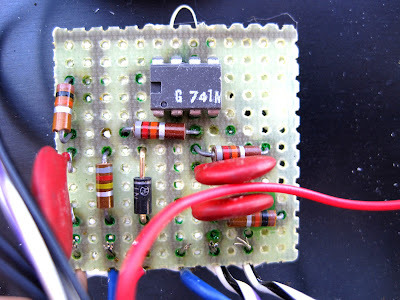
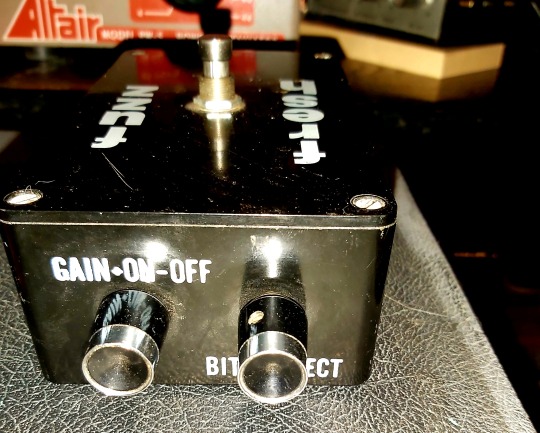
seamoon - fresh fuzz
V1, bakelite version
"The very first, very fragile, and very very rare V1 Seamoon Fresh Fuzz from 1973. The enclosure was made by Daka-ware (aka Davies Molding) using Bakelite plastic. Very few of these were made and even fewer survived ... Originally built in a plastic Bakelite project box, the Fresh Fuzz was one of the first distortion units to substitute an operational amplifier (op-amp) for the typical transistor-driven fuzz. This allowed for a massive volume boost that no other pedal had at the time. Excited guitar players quickly snatched them up, but were unfortunately met with a crushing realization when they actually stomped on one, as the delicate pedal would shatter into a million pieces! Anderton quickly abandoned the plastic box and switched over to the slanted metal casing we all know today, keeping the circuit untouched. These original units had a sound that was closer to a classic low gain distortion with a nice breakup (think ProCo Rat with less gain) than a buzzing fuzz. With a big beefy low end, and a smooth amp-like crunch, the V1 Fresh Fuzz really changed the game. But as new innovations tend to confuse the masses, people didn't get it."
cred: tonemachinesblog.com
25 notes
·
View notes
Text
I made a VCO that covers <0.03Hz through >13KHz out of crap and sticks!
6 generic op-amps, 3 generic transistors, 3 generic diodes, 1 capacitor and 20 resistors - and you, too, can have one TODAY, since my article on Ultra-Widerange Micro VCO is now out!



It's not a very precise VCO - it tracks exponentially and CV inputs can be tuned to track 1V/Oct over 2-3 octaves, but not more than that. But it requires no fancy or obsolete parts like a VCO chip or an OTA - just the most bread-n-butter parts ever. It's also a simple circuit and an easy build. If you were meaning to build an oscillator that is something more than an atari punk console, but all designs online are too complicated and have uncommon parts, this design just might be suitable for you!
Here's a basic sweep:
And here's some gross noise it and another VCO make in tandem!
As always, all the info, including schematics, circuit notes, more sound demos and module photos, veroboard layouts, etc, are in the article on my site. I'll drop the schem here, though, because for once i really like how it looks, despite in fact being a kinda hacky design.
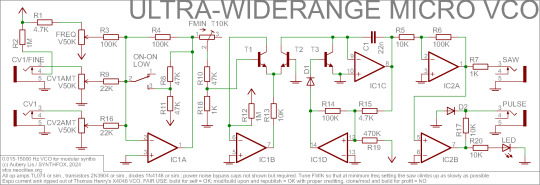
(i actually think the only reason it doesn't heat up is because TL07x are too slow for that to happen lmfao)
24 notes
·
View notes
Text





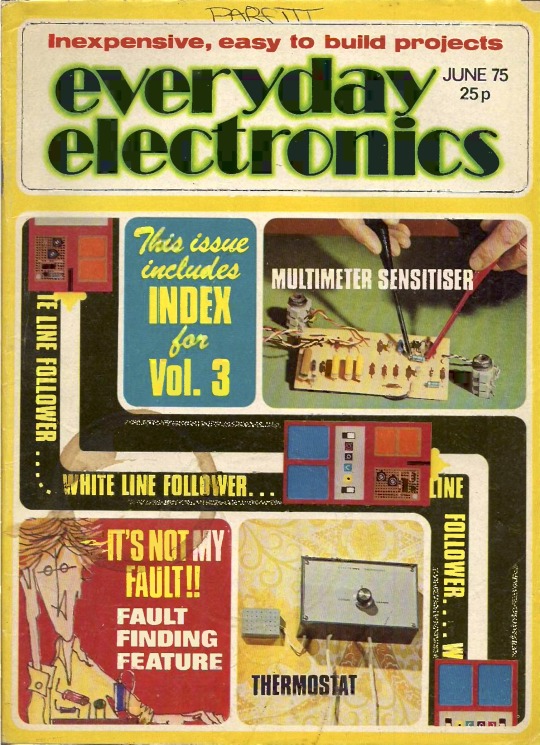
WiLF - White Line Follower by Malcolm Plant, in Everyday Electronics (1975). A novel electronic motorised vehicle that will follow a white line. The top two photos are of a build of WiLF by David Buckley from 1991. "The White Line Follower described in this article illustrates admirably the function of a control system known as a "servomechanism" incorporating the elements of command amplification, work and feedback. Two photocells mounted side-by-side "look at" the white line and provide the command signal when they "see" a difference of illumination. An operational amplifier (op. amp.) detects this differential command signal and via current buffer transistors and relays amplifies this signal to operate two electric motors connected to drive wheels. These motors provide the feedback essential for the vehicle to take corrective action in order to maintain equal illumination of the photocells. Thus the vehicle is compelled to follow the white line." – WiLF - White Line Follower, Everyday Electronics, June 1975.
29 notes
·
View notes
Text
Digital or analog?
First off, Welcome to Hi-Phi.
In this inaugural post, I will highlight the main difference between a fully digitalized amplifier, which is the most common today, to a completely (or almost completely) analog amplifier, plus a little extra, just for you <3. Please enjoy.
PS:please bear in mind this blog is for everyone and I will be explaining as much as possible to the best of my ability. Do not expect an extremely detailed run down!
Analog:

(taken from hi-fi news, Vacuum-packed: the "Airtight" amplifier)
Analog or valved amps were the first amplifiers to be created and are the living embodiment of: Grandpa is old, but he's no slouch! These bad boys can deliver amazing sound at great volume with a lower wattage than the new kids on the block. These things are also very customizable since all the sound depends on the type of vacuum tubes you put in. You want more bass? Change the tubes for a different family. You like the tubes already in the amp, but want more power? Stay in the same family, but switch to the next step-up!
These are the sort of shenanigans that would be harder to do on a digital amp, as you can't just unplug a transistor or a thyristor without having some technical know-how. Speaking of which, one of the glaring (yet stunning) problems with valved amps is in its namesake. The tubes (or valves) are very pretty to stare at, but, they require special treatment. The tubes are made from quartz. Quartz is known for not enjoying oils being rubbed on it, and the skin on our fingies have oils on them. YOU MUST NEVER TOUCH A VACUUM TUBE WITHOUT WEARING GLOVES. If you do, you must shower the tube in surgical spirit and wait for the spirit to evaporate, if you don't, I can almost guarantee that the tube will crack within one heat cycle. Keep a set of cotton gloves with the amp, just in case. Speaking of heat, tubes get hot, and quick, which is either a downside or an upside depending on the person!
Now, let us get technical. As I mentioned above, these amps can still deliver amazing sound with lower wattage, but what does any of that mean?.
To put it simply, Wattage means Power (literally) and the more power the more volume (usually), valved amps can still get loud with low wattage, yet, they shine with lower volumes as they keep their clarity without needing volume. They also usually have a great top end (treble), usually sounding clearer and more sparkly*, while still holding good sub-bass* and bass, of course this depends on the types of tubes you use. However, there is some objectivity to this, as with a valved amp you aren't distorting the sound as much as a digital amp would. Valved amps have the ability to produce smoother peaks* due to there being less digitalization of the music, this depends on how you are playing your music however, as if you are playing off a digital source than the type of file you are using still very much matters as well as the digital to analog converter* (DAC for short) and I've also heard that Upsampling* plays a major part in it, if your DAC is equipped with it.
(*Sparkly, in the audiophile world means a great and clear and defined treble, treble is where the high notes of music live, like Cymbals, flutes, and trumpets. Please refer to fig 1, this image also explains helps to explain sub-bass.)
(*Sub-bass, is the part of the music below the bass, this is where the very low notes in music live, like kick drums, cellos and low notes in bass guitars, please refer to fig.1 to help explain.)
(*Peaks referring to the Peaks of a wave, all sound is a form of a wave, and digitalization usually leaves small distortions or also known as artefacts in the peaks of music, please refer to fig.2)
(*Digital to analog converters, simply turn the 1s and 0s into a wave, which means sound. *Upsampling, uses complicated math that I am deffo not qualified to explain to fill in the gaps of 1s and 0s meaning a larger file size, this isn't detailed as this is a blog about amps not dacs. I If you are still interested, headphonesty this website has a great about dacs)
(fig.1) (taken from: https://www.status.co/blogs/the-journal/explaining-the-audio-frequency-spectrum-bass-mids-and-treble)
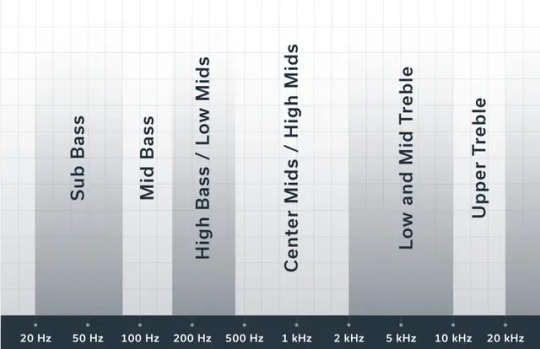
(fig.2) (taken from: https://opened.cuny.edu/courseware/lesson/33/student/?section=2)

Digital/Solid state:

(taken from MV audio lab)
Digital amps are a little harder to talk about, as they are not only the most common but also harder to visualize with all their semiconductors and such. I shall still try my best to simplify and remove as much of the subjectivity as possible. Digital amps generally have a lot more “comforts” than valved amps, usually that’s because digital amps are a lot more beginner-friendly thanks to them ridding themselves from expensive tubes and bespoke design. Chances are, if you buy a basic amplifier, you are getting a black (or silver if you are feeling luxurious), if you spring the money or get a real good deal, you will get a cute little screen.
On the other hand, this design isn’t a bad thing, you can virtually fit digital amps everywhere, and you can even really compact models that the tubes simply don’t allow. The lack of tubes also means that your amplifier won’t double as a space heater, no cotton gloves for delicate quartz, and an overall more predictable sound, did I mention Bluetooth?
Bluetooth or Wi-Fi connectivity is extremely comfortable and helps to rid pesky phone Amps and dongles that will affect sound, no wires mean less clutter in a small space. However, even if you have an older digital amp or analog there are DACs that have such features and at a decent price.
Digital Amps offer more power for cheaper, these things and easily push out 80 watts or more from something that can fit in a bag and sometimes a pocket! This power, comes at the cost of the sweet sounds of the tube, and often times, if you only focus on power you loose in the treble clarity and sometimes clarity in general.
Again, always note that with Digital amps, you will get some form of distortion due to said digitalization, meaning that the peaks will be stepped rather than smooth. However, amps nowadays deal quite well with that. You will lose the customizability of the tubes, but in return, usually you will get 2 small knobs for controlling the treble and the bass.
Again, what you lose in smoothness, you will get back in power however, if valved amps are wine, then solid state is whiskey, both can suck or as smooth as hell to the taste. But like I said, it all depends on the taste, and some people will naturally prefer whiskey than wine.
Now I won't go into the different classes of amps and such, but It's important to note that digital amps do have different classes and make-ups. There are some amps to avoid, (or so I've read), mainly the "New class A" technics amps, but the "Class AB" amps should be fine, (again so I have read, I haven't heard any of these Amps.)
Now if you are a beginner, and you probably are if you are reading this, you are probably going to get a digital amp, and I will not blame you. They are everywhere and sound great, even the older Pro stuff sounds damn good today (proud owner of a Kenwood KA-6100). However, let's say you are a person that wants the treble of the analog stuff, but you're a beginner or don't want to spend too much on an amp, you are in luck, Mr. President, there has been a third option.
THE CHEATER OPTION: Hybrid amplifier

(taken from the Mcintosh website, McIntosh MA252)
There is a reason why I called this the "Cheating Option", because like the examples I mentioned above, you will simply get the downsides of both styles of amps. You will need to spend the money to get a good hybrid amp. There are some decent picks and for good money, but I recommend not picking one up for your first proper amp. However, they are a great bridge between the 2 styles of amps, IF you can find a good one for decent money.
I will not talk about them here because I find them so fascinating that I want to talk about them alone in detail another time! However, there is this great blog I found on the matter that sums up the reason on why I wrote about them like I did: https://www.tubecad.com/april_may2001/
The end note:
Thank you so much for reading this decently sized blog, as you will notice I spent a lot of time talking about analog amps, that's because they are rarer and so there isn't an excellent starting point for people who know nothing about Hi-fi (I'm coping here). After all, i never even mentioned squeeze and push-pull set-ups (not to mention, I want to talk about in detail the make-ups of digital amps soon). Again, thank you so much, and I will see all of you wonderful tumblr people soon ;3 love you all, keep on rockin! <3
5 notes
·
View notes
Text
I think people who keep audio equipment with multiple high-power vacuum tubes in their house (whether it's a radio from the 50s or a guitar amp) are kinda crazy, I don't know that chasing that specific sound is worth the fire & shock hazard. I own a little 20W amp with one (1) small preamp tube in it and seeing it glow red hot when it powers on feels like I'm already asking for enough trouble. Technology has advanced well beyond the need for high-voltage transformers and tubes amplification, we have transistors and digital amplification now
3 notes
·
View notes
Text
i’ve actually been working on electronics things again for the first time in. a long ass time
updates


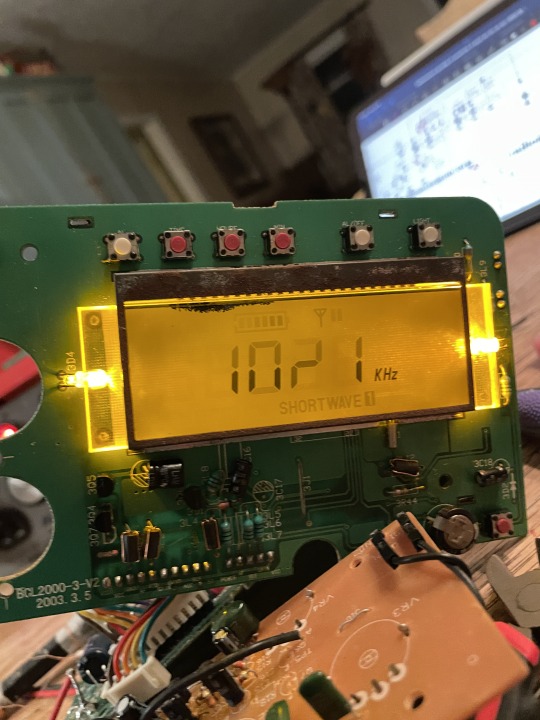

many years ago i was given this grundig s350 radio after my dingus coworkers at the time couldn’t fix it.
i could have sworn they installed a giant stupid capacitor somewhere, i think on a part of the circuit that isn’t used in an attempt to fix it. i guess i already removed it or that didnt actually happen. either way it still has the initial issue of there being no audio from the speaker or headphone jack.
in its time rusting and rotting in my parents wet moldy basement the lcd started having issues too. i managed to get my hands on a scan of the circuit diagram and worked my way through it. figured out the issue is that the audio amp has no power. line level works fine.
i replaced one 9015 transistor which i thought at the time could help the audio issue. it didn’t (cause that wasn’t actually how it worked i later learned) but it did fix the LCD… somehow?! earlier today though it developed a short which i figured out was a bad zener diode. i’m just waiting on parts now to replace that diode and one or maybe two transistors
2 notes
·
View notes
Text
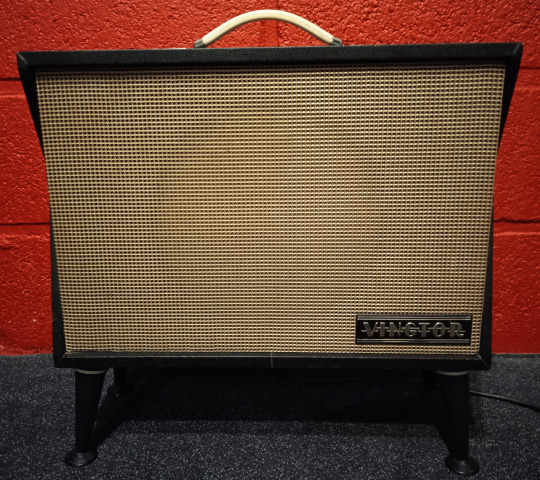


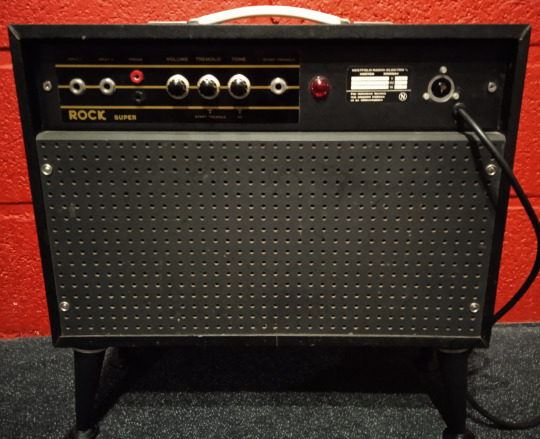

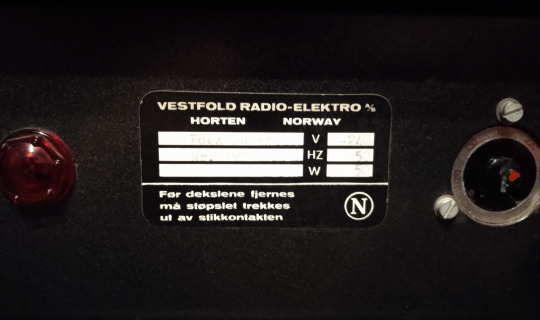


Here are some photos of one of my late repair. It's a very old man : a Vingtor Rock Super. I didn't find many informations on that brand. It seems that Vingtor was a norwegian company of the sixties, building hi-fi amps and guitar amps. That old transistor amp is probably from the mid-sixties.
I took the time to draw all the complete schematic in case someone of the internet needs it. I can't guarantee it's 100% accurate but I did my best. I'll post here soon.
1 note
·
View note
Text
OK enough about my problems.
The two old geezers from New York are at it again. Both are respected Golden Ears. (Maybe a bit deaf?)
youtube
Did you notice the bit about tuning drag race engines with no manifolds and mufflers? Oh and the very loud parties in the 70s. (Disco Baby!) Hearing Damage!
As far as the geezer label I am qualified. I think I am within a couple of years of the same age. I look way better.
The bit I want to focus on here is the Dynaco ST70 they swoon over. I have lived with one, and its bigger better brother the MK III 60 Watt mono blocks. So I am qualified. It is not crap, but it is not really that good. They are common and often sited as the gateway drug to this hobby.
If you want a brand new one well here they are:
And there are thousands out in the wild used and needing refreshing.
My central point in all the Blah Blah I have put in this site is we are discussing preference. What I like, what these Geezers like, is not a measure of absolute quality. It is what is preferred.
Also the circumstances of where you live and the music you listen to and wife and kids situation all play into this stew of life experience.
One of my rules (preferences) is get as much power as you can afford. Three digits worth are best. For me that even plays if you live in an apartment. For me power gives you clarity. Small amps turned up, rapidly sound strained and compressed.
The Stereo 70 is 35 Watts per side on a good day at 1% distortion. (brand new) My MKIIIs were 60 Watts and adequate. My Franken-Amp clips at 240 Watts.
So my preference is way different from what gets these old boys misty eyed. But everyone is an audiophile right? Oh yes I have that Diva ARC amp, but she would absolutely blow the Dynacos out of the yard. The St 70 and MkIII were designed in the 1950s. My ARC was designed 40 years later with better parts and engineering.
So two points.
First is can people such as these be depended upon to give an honest and accurate appraisal of things? Consumers and hobbyists depend on them more than a little. Will they call it right if it really is not as good as it could be? (They did a previous duet on why they never give negative reviews)
Second is what actually is the standard? I have speculated before there should be a line to cross between OK and really good. The reviewers job should be to say what side of that line we are on. In my experience the ARC products have always been over that line in their respective eras. Dynaco sometimes close but never really past that line. My Franken-Amp is mostly a Dynaco 400 that I pushed over that line.
Well at least that is my opinion.
If you want to test the Tube amp waters a Stereo 70 is probably the least expensive option. And It can be sold on for about what you pay for it.
I may have said this before, but I like tube amps and the way they work. There is a simple mechanical elegance to them. I can literally visualize how the electrons swirl around the circuits. I do not get that with solid state. That is like a concrete wall to me. (I used to design concrete walls, oh and floors and beams in another life)
So life goes on. I think I gotta turn up the music tonight.
#audiophile#high end audio#audioblr#tubes vs transistors#Tube audio#Tube amps#vacuum tubes#Dynaco ST70#Youtube
1 note
·
View note
Text

Got a good deal on this Sony amp / equalizer, was sold as broken.
According to the seller, everything seemed to work except the issue is that connected speakers sound fuzzy and poppy, but when I first tested it I didn't notice anything off. However, when I tried switching the speakers from A -> B then back, I could hear what they were talking about and it sounded bad. But if I fiddled with the knob a bit, it sounded fine again
I was initially expecting to have to do some repairs in the field of replacing transistors or recaping it, but if I'm right this fix is stupid simple.
What I think is that there's literally nothing wrong with it, the knob just needs some cleaning or may need to be replaced. What's causing the issue is that its getting caught in between the two speaker options and not making a full connection, leading to the intermittent sound. Planning to still open it up to clean it and out and will recap if any look bad, but this came before the capacitor plague era so hopefully it'll be fine.
Excited to get it all cleaned and set up :)
3 notes
·
View notes
Text

Dandy Boy
Written for @flashfictionfridayofficial 243rd prompt.
Word count: 538
Audience: General
Themes: musical performances, emotional responses, slice of life
Descending the stairs, I approach the disco pop hell hole that has imprisoned my attention this last week. Such posh places were usually beneath me. I am much too old for curated vibrancy that only attracts young, flighty patrons with fleeting attention. This particular pocket of technicolor hell held an anomaly, however. A vast soul caged in a vapid gig.
I breathe in a deep puff of cotton candy cloud and snort the exhale at the no vaping sign that nobody follows at the bottom of the stairwell. I place my hand on the gaudiest velvet-clad door and push into the offensively neon venue. As an old woman, I trail an aura of grey through the pastel energies of today's youth gathered in this snug club. I don't belong, and I don't care. All I care about is that, in this unexpected place, is where the music happens. Not this spliced and sliced chords and bars pieced together by software and black boxes that I had grown accustomed to in the slog of shows I must sit through daily, but actual, grassroots composition born from tube amps, strings, and profound sadness. Pushing against the collection of confused stares, I make my presence known at the 10-seat wood top tucked in the back of this flashing sign and velvet box. I order what I've ordered the last four days I've been here; a Manhattan is burning, which, while cleverly named, was all flare and no flavor. I found myself at my corner booth, where I just sipped and waited.
It was mere moments before the object of my obsessions stumbles onto the cramped corner stage. A shy swallow who chirps an enchanting melancholic melody. He was a dandy dime, all glitter and blues. He has big, slick black hair and dark skin, a beautiful contrast to his foil-textured white fitted suit top sporting a deep v and a thoughtful gaze that never leaves his lifted-heeled boots. His Epiphone 8 string, a shimmering baby blue, plugged into a burnt orange tube amplifier. He drips with a brilliant shyness and sorrow, dressed in an awkward guise of confident colors and attire. I hold my breath while waiting for his set reveal, ready to be infected with his unexpected sparkle.
And then, he sings. He strums. The warm reverb of the transistor tubes worms through the pastel plain and hits my grey. He fills the room and turns it bold. Turns it blue. His performance erases the neon, coats the velvet, and masks the humanity of the room. All is him, and he is all. A deep baritone voice, crass and uneven, solid and vibrant, blends with the strings' vibration. His music is home, love, heartbreak, and loss. His music holds life and tells of change. This utter stranger has given me things I never knew I needed and showed me there is life I am missing to live.
At the end of the set, I release myself from my viewing station and approach the stage, money in my hand to show proper appreciation for the once again visceral performance. Throwing the cash into the open guitar case, I address the only thing in the room with soul.
"Excellent work, Dandy Boy."
6 notes
·
View notes
Text
Top McIntosh Labs 2-Channel Integrated Amplifiers: Ultimate Buyer’s Guide
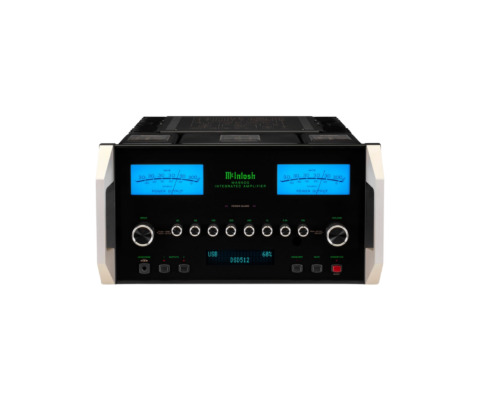
When it comes to high-fidelity audio, few names command as much respect as McIntosh Labs. Known for its signature blue watt meters, polished glass front panels, and robust power delivery, McIntosh has become synonymous with audio perfection. If you're an audiophile searching for the ultimate listening experience, investing in a McIntosh Labs 2-Channel Integrated Amplifier could be a transformative upgrade.
This guide explores some of the best McIntosh integrated amplifiers in the 2-channel category, helping you choose the perfect model for your stereo setup.
Why Choose a McIntosh 2-Channel Integrated Amplifier?
A McIntosh Labs 2-Channel Integrated Amplifier combines a preamplifier and power amplifier in one chassis, preserving signal integrity while minimizing component clutter. McIntosh amps are revered for:
Exceptional sound clarity and headroom
Handcrafted construction in the USA
Timeless design with signature blue meters
Durability and resale value
Wide speaker compatibility
Whether you're driving bookshelf speakers or high-end floorstanders, McIntosh delivers the dynamics and warmth every audiophile craves.
Top McIntosh Labs 2-Channel Integrated Amplifiers
1. McIntosh MA252 Hybrid Integrated Amplifier
Power Output: 100W per channel into 8 ohms Design: Tube preamp + solid-state power amp
The MA252 is McIntosh’s first hybrid integrated amplifier, merging retro tube warmth with modern solid-state muscle. It features 12AX7a and 12AT7 preamp tubes, paired with a powerful transistor-based amplifier section.
Ideal For: Listeners who love rich mids and smooth highs without sacrificing punch.
2. McIntosh MA5300 Solid-State Integrated Amplifier
Power Output: 100W per channel into 8 ohms Design: Solid-state, compact footprint
The MA5300 is the most compact McIntosh Labs 2-Channel Integrated Amplifier, making it perfect for small-to-medium-sized rooms. It includes a built-in DAC with support for DSD and DXD formats, making it ideal for digital music lovers.
Ideal For: Modern audiophiles with digital streaming setups and space constraints.
3. McIntosh MA7200 Integrated Amplifier
Power Output: 200W per channel into 8 ohms Design: Solid-state, robust build
The MA7200 delivers exceptional power and sonic precision, thanks to its Direct Coupled Output design. It also features the McIntosh DA1 Digital Audio Module for high-res playback and future-proofing.
Ideal For: Audiophiles with demanding speakers and a mix of analog and digital sources.
4. McIntosh MA8900 Integrated Amplifier
Power Output: 200W per channel into 8 ohms Design: Fully loaded with analog and digital features
The MA8900 brings the best of both worlds—vintage McIntosh aesthetics and cutting-edge digital technology. It includes the DA1 DAC module, tone controls, five-band equalizer, and McIntosh’s advanced Autoformers for consistent output.
Ideal For: Serious listeners who want custom control and audio versatility.
5. McIntosh MA12000 Hybrid Integrated Amplifier
Power Output: 350W per channel into 8 ohms Design: Tube preamp + solid-state powerhouse
The flagship McIntosh Labs 2-Channel Integrated Amplifier, the MA12000 combines a 350W solid-state amplifier with a 12AX7 tube preamplifier. It offers 17 inputs, cutting-edge DAC technology, and unmistakable McIntosh build quality.
Ideal For: Audiophiles who want it all—power, detail, flexibility, and iconic presence.
Key Features to Consider When Buying
Power Output: Match the wattage to your speakers’ sensitivity.
Digital Inputs: Choose models with DACs if you stream high-res music.
Tube vs. Solid-State: Tubes offer warmth; solid-state provides precision.
Size and Ventilation: McIntosh amps are heavy and need space to breathe.
Budget: Prices range from ₹4–15+ lakhs depending on model and features.
Final Thoughts
A McIntosh Labs 2-Channel Integrated Amplifier is not just an audio device—it's a statement piece. It promises decades of flawless performance, sophisticated design, and unmatched sonic delivery. Whether you're a purist chasing analog bliss or a modern listener streaming high-res tracks, there’s a McIntosh amp tailored for your dream setup.
0 notes
Text


BOSS - CE-1 Chorus Ensemble
"... yeah, there’s a reason why they occupy so much Cabinet real estate. The company created the “first” of a variety of effects, and was certainly the first to offer many types in compact boxes. However, one such pedal is a stone-cold all-time classic despite never being offered in Boss’s trademark compact enclosure. That pedal is the CE-1 Chorus Ensemble.
Released one year after parent company Roland’s flagship Jazz Chorus amplifiers, Boss did what was once considered the unthinkable. Following the rapid and perhaps unexpected success of the aforementioned amp series, Roland wasted no time with ripping a circuit straight from them and putting them in a floor unit. In fact, this circuit ended up being the first pedal to bear the Boss name, and what a first it was.
Back when the CE-1 was conceptualized, the idea of mains-powered pedals was pretty commonplace. Mu-Tron effects used them, and so did MXR on some of its more ambitious models. Onboard and oftentimes custom-wound transformers ensured that voltages would be stepped down at precisely the right increments in order to preserve tonal integrity and headroom.
Of course, most pedals of the time also ran on nine-volt batteries, establishing a standard that continues today. But before these standards were established, the idea of grandiose effects thrived under the usage of mains power. Such a boundless canvas allowed companies like Boss to rip entire hunks of circuitry straight from larger silicon conglomerates and put them right at a player’s feet. These days, very few manufacturers offer such exacting circuitry, and the few that do charge exorbitant prices.
The CE-1 is one particularly exceptional example of this practice, because it expands on the original circuit, with the added bonus that you can play it through an actual tube amplifier. It also adds an extra functionality that the Jazz Chorus just couldn’t match. The Jazz Chorus gives players both Chorus and Vibrato modes, and to that end, serves up three knobs, of which Speed and Depth are two. The third knob is actually a rotary switch that chooses either mode. While the JC-120 offers a footswitch input to toggle the effect on and off, the CE-1 does one better and converts the rotary switch into a stompable button, meaning you don’t have to do the Angus Young duckwalk back to your amp mid-set to change modes. Nobody wants to do this.
Roland’s Jazz Chorus—and thusly the CE-1—couldn’t have come at a better time for end-users or commerce. Californian semiconductor company Reticon developed the first bucket-brigade device (BBD) and distributed them through the usual suspects, including Radio Shack under the store’s in-house Archer brand. The only problem—again for end-users and commerce—was that each one cost a crazy amount of 1970s dollars. Even at wholesale prices, Reticon’s SAD series of BBD chips made effects a bit on the expensive side.
Shortly after in Japan, Matsushita released the genesis of the Japanese BBD boom that ended up sinking Reticon and all pedals that relied on it. The first chip off the Matsushita line was the MN3002 and found its way into the CE-1 tout de suite. With the combination of the relatively inexpensive BBD and the full-strength brawn of the circuit itself, the CE-1 made a splash in the effects world and primed the pump for Boss’s compact series to take the effects world by storm.
The most unsung piece of the CE-1 puzzle is the onboard preamp that preps the signal for its impending modulation. While many effects and amplifiers (especially of this era) features “high” and “low” inputs, they usually correspond to a brute force approach that swaps out resistors in the signal path. However, the CE-1 preamp section starts with an op-amp preamp circuit that sweetens the signal, and switching over to high mode inserts a transistorized gain stage between the input and the op-amp section. This adds a velvety gloss to the signal before it ever sniffs the BBD chip, catapulting your tone into heights unreached by lesser devices.
It’s not often that almost 50 years later, no effect of a given type has surpassed the first one ever created, but such is the case with the CE-1. Its combination of unsurpassed tonal brilliance, component count and wacky power requirements has cemented its place in the effects hall of fame, leaving even the most modern refinements squarely in the rear-view mirror."
cred: catalinbread.com/blogs/kulas-cabinet/boss-ce-1-chorus-ensemble
48 notes
·
View notes